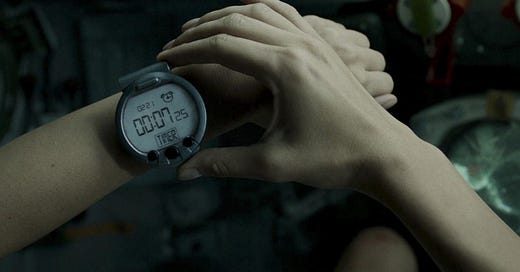This week’s rebroadcast pulls posts from 2006 and 2020 together for some myth-busting and helpful reframing.
Back in 2006, I answered a reader question about page counts:
Every screenwriting book I’ve read, class I took, and basically the first rule I learned says:
ONE PAGE OF A PROPERLY FORMATTED SCRIPT = APPROX. A MINUTE OF SCREEN TIME.
I know one page of say a battle can last five minutes whereas one page of quick dialogue my last ten seconds if the actors talk fast. So my question is, is this rule true?
The one-page-per-minute rule of thumb doesn’t hold up to much scrutiny. True, most screenplays are about 120 pages, and true, most movies are around two hours. But the conversion rate between paper and celluloid is rarely one-to-one.1
That’s why when a movie is in pre-production, one of the script supervisor’s first jobs is to time the script. They read through the screenplay with a stopwatch, estimating how long each scene will play, then add up the total running time. Generally, they go through the whole script twice, averaging the times.
How accurate is the script timing? Well, that depends on how well the script supervisor has factored in the director’s style. Ang Lee’s Brokeback Mountain featured long, contemplative shots of the heroes herding sheep, which another director might have dropped altogether. But generally, the script timing is in the right ballpark.
Although a script supervisor has more experience, you can time a script yourself. My advice would be to read the dialogue aloud, while trying to pad for non-spoken moments. It’s easier with some scripts than others.
As far as my own films:
Go was 126 pages, but came out at 103 minutes — without any major scenes left out. It wasn’t play-like, but the pacing was quick.
Big Fish was 124 pages, and 125 minutes long. To my recollection, only one significant scene was omitted, so the page-per-minute rule came close.
Both Charlie’s Angels movies went through so many drafts during production that an accurate page-count is impossible. But the first drafts were around 120 pages. The original film was 98 minutes; the sequel was 106. The pacing was obviously quick.
Charlie and the Chocolate Factory: 128 pages, 115 minutes.
Corpse Bride: 73 pages, 76 minutes.
I started thinking about this question again, and realized there was an opportunity to reframe the question in a more concrete way:
For screenplays, what is the correlation between screenplay length and running time?
I asked data scientist Stephen Follows if he’d be up for tackling this question. He jumped into action, gathering 761 feature screenplays and comparing them to the running times of their finished films.
The results largely match what I expected.
While Follows finds there is some obvious correlation between page count and running time, the rule of thumb barely works in aggregate but isn’t very predictive for any given project.
Why does it matter? Because too many folks in the film and television industry have internalized one-page-per-minute as an axiomatic truth rather than a crude estimate. Any script that is longer than 120 pages is perceived as being too long. Indeed, some studios’ contracts specify that the writer may not deliver a script longer than 120 pages.2
In order to bring their scripts under this artificial limit, screenwriters waste time making tiny edits with the goal of moving page breaks. It’s pointless busy work.
Worse, the page-per-minute rule of thumb puts too much focus on arbitrary sheets of never-printed paper rather than the words they contain. If we’re worried about the length of anything, it should be scenes and sequences. But we continue to treat screenplays as if they’re hand-typed on dead trees, forgoing digital tools that would allow for better security, collaboration and version control.
As an industry, we’re afraid to move to new formats for screenplays because we’re worried it’ll break the page-per-minute standard. But we don’t need to worry, because the rule of thumb was never really true.
Doing what makes sense
Is it appropriate to try to estimate a project’s running time based on the script? Absolutely.
Is there an opportunity for computer-generated running time estimates? Probably.
With machine learning, I can imagine systems that better predict how words on the page will reflect minutes on screen. But I wonder if it’s a false goal. Ultimately, running time is a factor of film editing. Scenes get dropped in post, and it’s very hard to anticipate these changes when looking at a script in preproduction.
This analysis was done on feature films, but every TV show faces similar issues. However, long-running shows have the advantage of knowing how their specific show works. My hunch is that every NCIS script falls in a narrow range of scenes and pages because they know what they need.
Big thanks to Stephen Follows for accepting this challenge and myth-busting this rule of thumb. Be sure to read, share and comment on his post.
Are you enjoying this newsletter?
📧 Forward it to a friend and suggest they check it out.
🔗 Share a link to this post on social media.
🗣 Have ideas for future topics (or just want to say hello)? Reach out to Chris via email at inneresting@johnaugust.com, Twitter @ccsont, or Mastodon @ccsont@mastodon.art
Celluloid! It truly was a different age in 2006.
On a recent project, my contract limited delivery to 130 pages. Such decadence!




